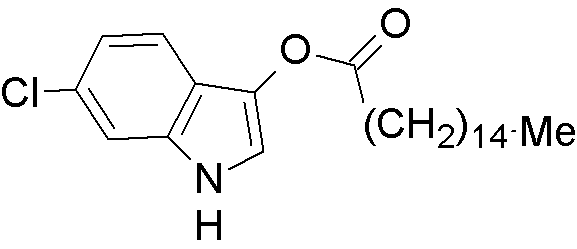6-Chloro-3-indoxyl palmitate is widely utilized in research focused on:
- Histochemical Staining: This compound serves as a substrate in histochemical assays, allowing researchers to visualize specific enzymatic activities in tissues, enhancing the understanding of cellular processes.
- Biochemical Research: It is used in studies involving lipid metabolism and enzyme activity, providing insights into metabolic pathways and potential therapeutic targets.
- Pharmaceutical Development: The compound aids in drug formulation and testing, particularly in developing compounds targeting specific biological pathways, thus streamlining the drug discovery process.
- Plant Biology: It is applied in plant research to study gene expression and protein function, helping scientists understand plant responses to environmental changes.
- Diagnostic Applications: This chemical can be utilized in developing diagnostic tools for diseases, allowing for early detection and improved patient outcomes through targeted therapies.
General Information
Properties
Safety and Regulations
Applications
6-Chloro-3-indoxyl palmitate is widely utilized in research focused on:
- Histochemical Staining: This compound serves as a substrate in histochemical assays, allowing researchers to visualize specific enzymatic activities in tissues, enhancing the understanding of cellular processes.
- Biochemical Research: It is used in studies involving lipid metabolism and enzyme activity, providing insights into metabolic pathways and potential therapeutic targets.
- Pharmaceutical Development: The compound aids in drug formulation and testing, particularly in developing compounds targeting specific biological pathways, thus streamlining the drug discovery process.
- Plant Biology: It is applied in plant research to study gene expression and protein function, helping scientists understand plant responses to environmental changes.
- Diagnostic Applications: This chemical can be utilized in developing diagnostic tools for diseases, allowing for early detection and improved patient outcomes through targeted therapies.
Documents
Safety Data Sheets (SDS)
The SDS provides comprehensive safety information on handling, storage, and disposal of the product.
Product Specification (PS)
The PS provides a comprehensive breakdown of the product’s properties, including chemical composition, physical state, purity, and storage requirements. It also details acceptable quality ranges and the product's intended applications.
Certificates of Analysis (COA)
Search for Certificates of Analysis (COA) by entering the products Lot Number. Lot and Batch Numbers can be found on a product’s label following the words ‘Lot’ or ‘Batch’.
*Catalog Number
*Lot Number
Certificates Of Origin (COO)
This COO confirms the country where the product was manufactured, and also details the materials and components used in it and whether it is derived from natural, synthetic, or other specific sources. This certificate may be required for customs, trade, and regulatory compliance.
*Catalog Number
*Lot Number
Safety Data Sheets (SDS)
The SDS provides comprehensive safety information on handling, storage, and disposal of the product.
DownloadProduct Specification (PS)
The PS provides a comprehensive breakdown of the product’s properties, including chemical composition, physical state, purity, and storage requirements. It also details acceptable quality ranges and the product's intended applications.
DownloadCertificates of Analysis (COA)
Search for Certificates of Analysis (COA) by entering the products Lot Number. Lot and Batch Numbers can be found on a product’s label following the words ‘Lot’ or ‘Batch’.
*Catalog Number
*Lot Number
Certificates Of Origin (COO)
This COO confirms the country where the product was manufactured, and also details the materials and components used in it and whether it is derived from natural, synthetic, or other specific sources. This certificate may be required for customs, trade, and regulatory compliance.

